Financial Management Assignment: Valuation and Debt
VerifiedAdded on 2021/01/02
|10
|2645
|23
Homework Assignment
AI Summary
This finance assignment solution delves into crucial corporate finance topics. It begins with an analysis of free cash flow to equity and firm valuation, exploring the golden rule of value-creating growth and sustainable growth components. The assignment then examines Modigliani-Miller propositions, their significance, and the application of the CAPM model. It further explores the emergence of the trade-off theory and the estimation of financial distress costs using an option pricing approach. The solution also covers the circumstances for using the Discounted Free Cash Flow to Firm model, valuation models for leveraged buyouts (LBOs), and the valuation of early-stage companies with no profits. Finally, it discusses the reasoning behind using put-call parity.

Questions
Paraphrase This Document
Need a fresh take? Get an instant paraphrase of this document with our AI Paraphraser
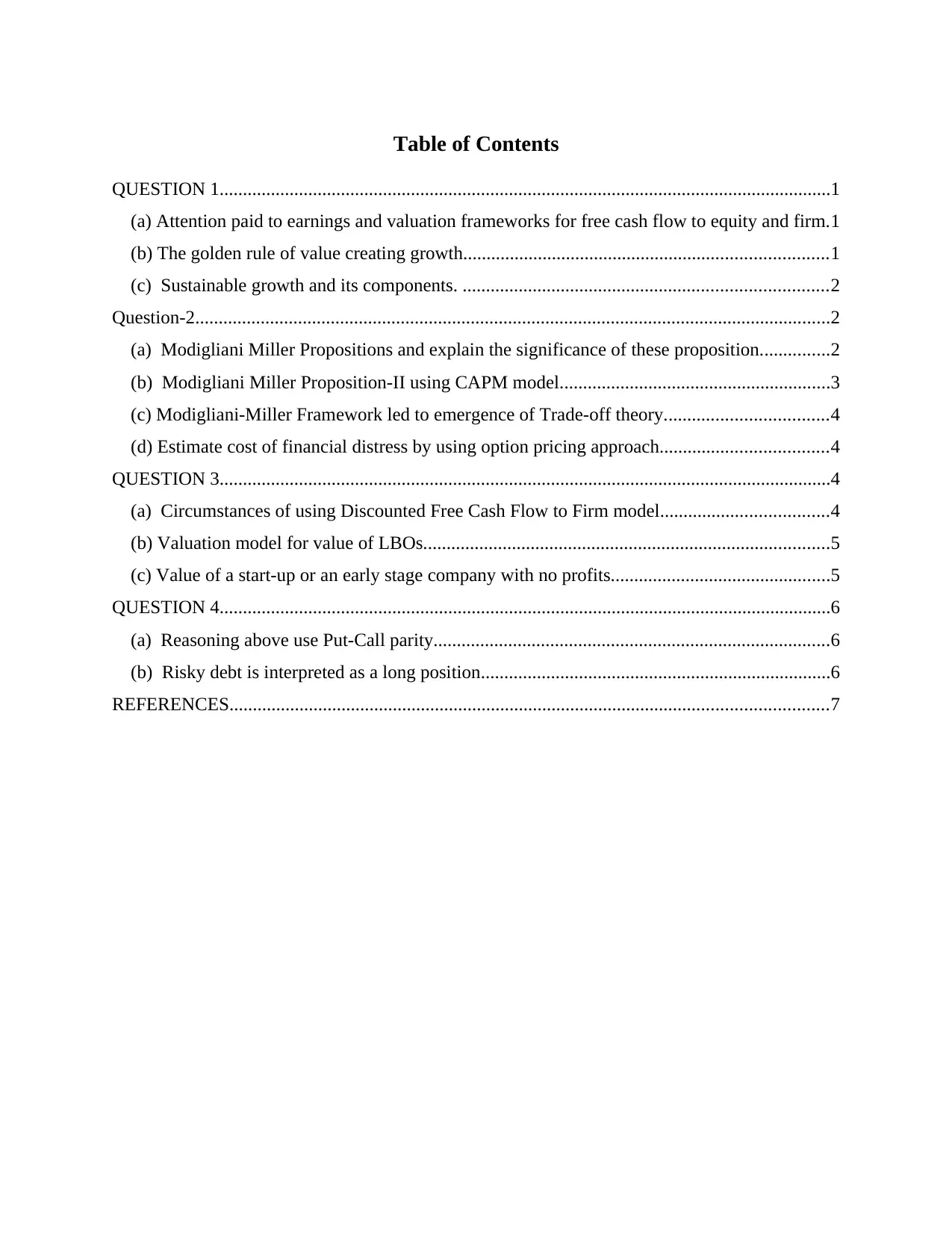
Table of Contents
QUESTION 1...................................................................................................................................1
(a) Attention paid to earnings and valuation frameworks for free cash flow to equity and firm.1
(b) The golden rule of value creating growth..............................................................................1
(c) Sustainable growth and its components. ..............................................................................2
Question-2........................................................................................................................................2
(a) Modigliani Miller Propositions and explain the significance of these proposition...............2
(b) Modigliani Miller Proposition-II using CAPM model..........................................................3
(c) Modigliani-Miller Framework led to emergence of Trade-off theory...................................4
(d) Estimate cost of financial distress by using option pricing approach....................................4
QUESTION 3...................................................................................................................................4
(a) Circumstances of using Discounted Free Cash Flow to Firm model....................................4
(b) Valuation model for value of LBOs.......................................................................................5
(c) Value of a start-up or an early stage company with no profits...............................................5
QUESTION 4...................................................................................................................................6
(a) Reasoning above use Put-Call parity.....................................................................................6
(b) Risky debt is interpreted as a long position...........................................................................6
REFERENCES................................................................................................................................7
QUESTION 1...................................................................................................................................1
(a) Attention paid to earnings and valuation frameworks for free cash flow to equity and firm.1
(b) The golden rule of value creating growth..............................................................................1
(c) Sustainable growth and its components. ..............................................................................2
Question-2........................................................................................................................................2
(a) Modigliani Miller Propositions and explain the significance of these proposition...............2
(b) Modigliani Miller Proposition-II using CAPM model..........................................................3
(c) Modigliani-Miller Framework led to emergence of Trade-off theory...................................4
(d) Estimate cost of financial distress by using option pricing approach....................................4
QUESTION 3...................................................................................................................................4
(a) Circumstances of using Discounted Free Cash Flow to Firm model....................................4
(b) Valuation model for value of LBOs.......................................................................................5
(c) Value of a start-up or an early stage company with no profits...............................................5
QUESTION 4...................................................................................................................................6
(a) Reasoning above use Put-Call parity.....................................................................................6
(b) Risky debt is interpreted as a long position...........................................................................6
REFERENCES................................................................................................................................7
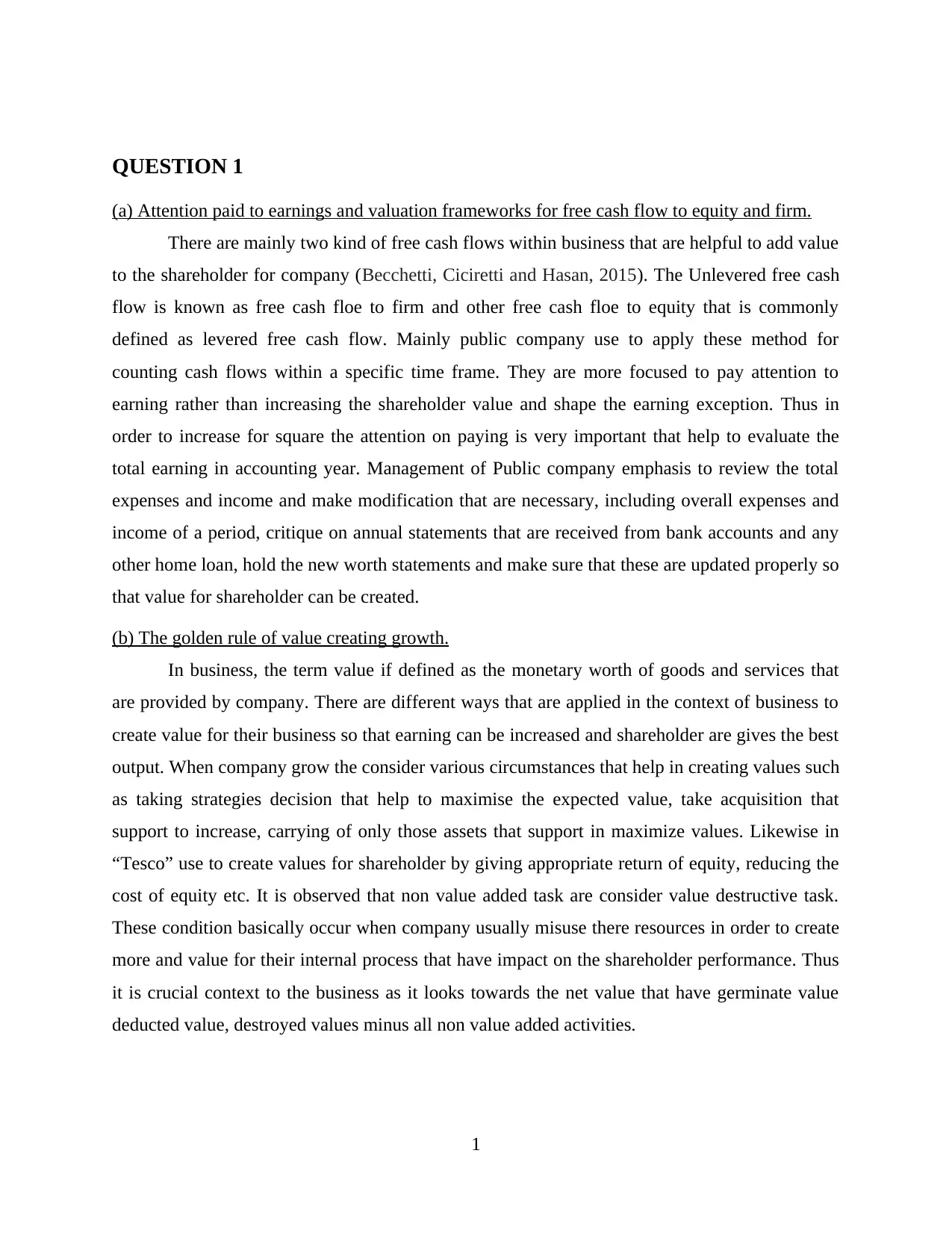
QUESTION 1
(a) Attention paid to earnings and valuation frameworks for free cash flow to equity and firm.
There are mainly two kind of free cash flows within business that are helpful to add value
to the shareholder for company (Becchetti, Ciciretti and Hasan, 2015). The Unlevered free cash
flow is known as free cash floe to firm and other free cash floe to equity that is commonly
defined as levered free cash flow. Mainly public company use to apply these method for
counting cash flows within a specific time frame. They are more focused to pay attention to
earning rather than increasing the shareholder value and shape the earning exception. Thus in
order to increase for square the attention on paying is very important that help to evaluate the
total earning in accounting year. Management of Public company emphasis to review the total
expenses and income and make modification that are necessary, including overall expenses and
income of a period, critique on annual statements that are received from bank accounts and any
other home loan, hold the new worth statements and make sure that these are updated properly so
that value for shareholder can be created.
(b) The golden rule of value creating growth.
In business, the term value if defined as the monetary worth of goods and services that
are provided by company. There are different ways that are applied in the context of business to
create value for their business so that earning can be increased and shareholder are gives the best
output. When company grow the consider various circumstances that help in creating values such
as taking strategies decision that help to maximise the expected value, take acquisition that
support to increase, carrying of only those assets that support in maximize values. Likewise in
“Tesco” use to create values for shareholder by giving appropriate return of equity, reducing the
cost of equity etc. It is observed that non value added task are consider value destructive task.
These condition basically occur when company usually misuse there resources in order to create
more and value for their internal process that have impact on the shareholder performance. Thus
it is crucial context to the business as it looks towards the net value that have germinate value
deducted value, destroyed values minus all non value added activities.
1
(a) Attention paid to earnings and valuation frameworks for free cash flow to equity and firm.
There are mainly two kind of free cash flows within business that are helpful to add value
to the shareholder for company (Becchetti, Ciciretti and Hasan, 2015). The Unlevered free cash
flow is known as free cash floe to firm and other free cash floe to equity that is commonly
defined as levered free cash flow. Mainly public company use to apply these method for
counting cash flows within a specific time frame. They are more focused to pay attention to
earning rather than increasing the shareholder value and shape the earning exception. Thus in
order to increase for square the attention on paying is very important that help to evaluate the
total earning in accounting year. Management of Public company emphasis to review the total
expenses and income and make modification that are necessary, including overall expenses and
income of a period, critique on annual statements that are received from bank accounts and any
other home loan, hold the new worth statements and make sure that these are updated properly so
that value for shareholder can be created.
(b) The golden rule of value creating growth.
In business, the term value if defined as the monetary worth of goods and services that
are provided by company. There are different ways that are applied in the context of business to
create value for their business so that earning can be increased and shareholder are gives the best
output. When company grow the consider various circumstances that help in creating values such
as taking strategies decision that help to maximise the expected value, take acquisition that
support to increase, carrying of only those assets that support in maximize values. Likewise in
“Tesco” use to create values for shareholder by giving appropriate return of equity, reducing the
cost of equity etc. It is observed that non value added task are consider value destructive task.
These condition basically occur when company usually misuse there resources in order to create
more and value for their internal process that have impact on the shareholder performance. Thus
it is crucial context to the business as it looks towards the net value that have germinate value
deducted value, destroyed values minus all non value added activities.
1
⊘ This is a preview!⊘
Do you want full access?
Subscribe today to unlock all pages.

Trusted by 1+ million students worldwide
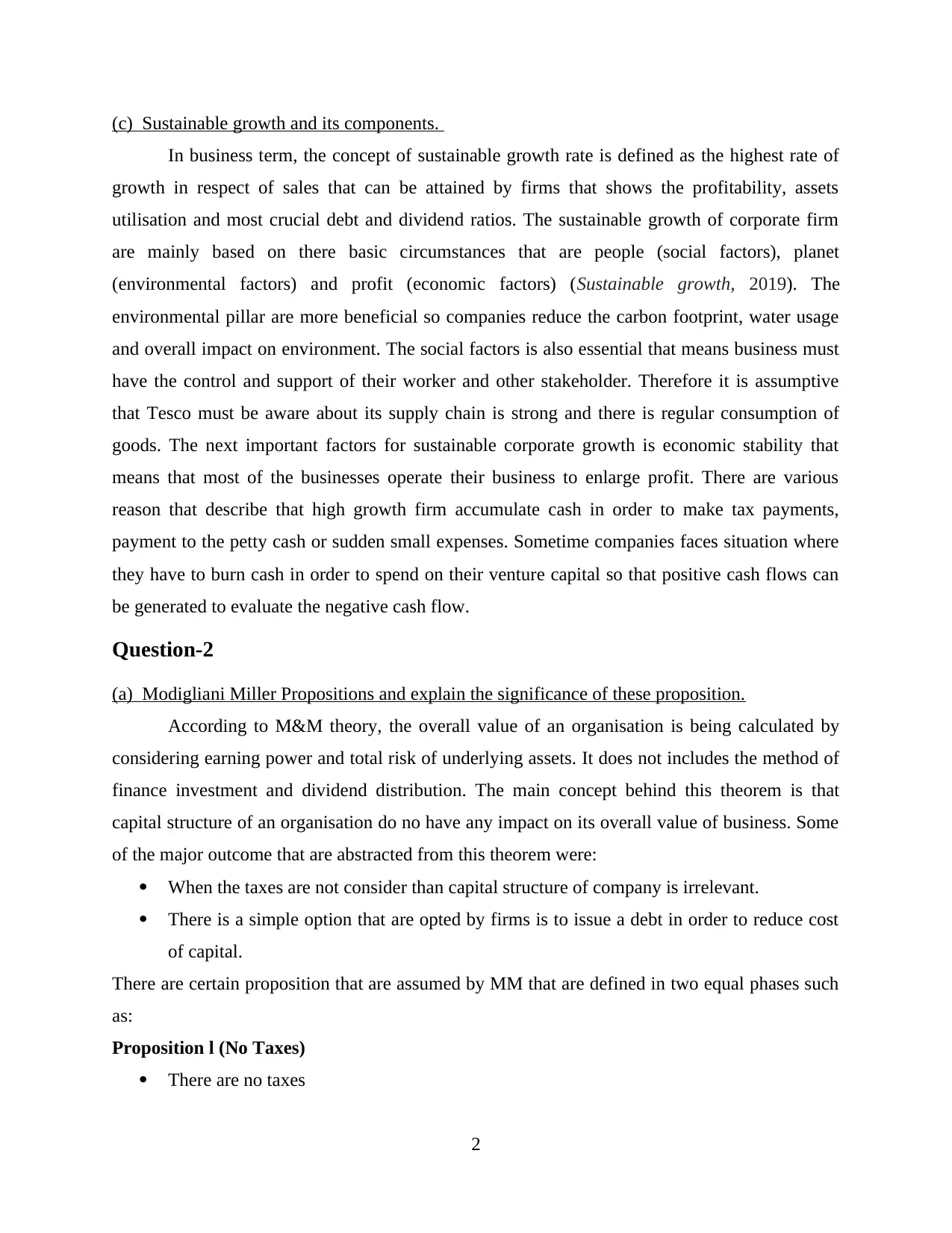
(c) Sustainable growth and its components.
In business term, the concept of sustainable growth rate is defined as the highest rate of
growth in respect of sales that can be attained by firms that shows the profitability, assets
utilisation and most crucial debt and dividend ratios. The sustainable growth of corporate firm
are mainly based on there basic circumstances that are people (social factors), planet
(environmental factors) and profit (economic factors) (Sustainable growth, 2019). The
environmental pillar are more beneficial so companies reduce the carbon footprint, water usage
and overall impact on environment. The social factors is also essential that means business must
have the control and support of their worker and other stakeholder. Therefore it is assumptive
that Tesco must be aware about its supply chain is strong and there is regular consumption of
goods. The next important factors for sustainable corporate growth is economic stability that
means that most of the businesses operate their business to enlarge profit. There are various
reason that describe that high growth firm accumulate cash in order to make tax payments,
payment to the petty cash or sudden small expenses. Sometime companies faces situation where
they have to burn cash in order to spend on their venture capital so that positive cash flows can
be generated to evaluate the negative cash flow.
Question-2
(a) Modigliani Miller Propositions and explain the significance of these proposition.
According to M&M theory, the overall value of an organisation is being calculated by
considering earning power and total risk of underlying assets. It does not includes the method of
finance investment and dividend distribution. The main concept behind this theorem is that
capital structure of an organisation do no have any impact on its overall value of business. Some
of the major outcome that are abstracted from this theorem were:
When the taxes are not consider than capital structure of company is irrelevant.
There is a simple option that are opted by firms is to issue a debt in order to reduce cost
of capital.
There are certain proposition that are assumed by MM that are defined in two equal phases such
as:
Proposition l (No Taxes)
There are no taxes
2
In business term, the concept of sustainable growth rate is defined as the highest rate of
growth in respect of sales that can be attained by firms that shows the profitability, assets
utilisation and most crucial debt and dividend ratios. The sustainable growth of corporate firm
are mainly based on there basic circumstances that are people (social factors), planet
(environmental factors) and profit (economic factors) (Sustainable growth, 2019). The
environmental pillar are more beneficial so companies reduce the carbon footprint, water usage
and overall impact on environment. The social factors is also essential that means business must
have the control and support of their worker and other stakeholder. Therefore it is assumptive
that Tesco must be aware about its supply chain is strong and there is regular consumption of
goods. The next important factors for sustainable corporate growth is economic stability that
means that most of the businesses operate their business to enlarge profit. There are various
reason that describe that high growth firm accumulate cash in order to make tax payments,
payment to the petty cash or sudden small expenses. Sometime companies faces situation where
they have to burn cash in order to spend on their venture capital so that positive cash flows can
be generated to evaluate the negative cash flow.
Question-2
(a) Modigliani Miller Propositions and explain the significance of these proposition.
According to M&M theory, the overall value of an organisation is being calculated by
considering earning power and total risk of underlying assets. It does not includes the method of
finance investment and dividend distribution. The main concept behind this theorem is that
capital structure of an organisation do no have any impact on its overall value of business. Some
of the major outcome that are abstracted from this theorem were:
When the taxes are not consider than capital structure of company is irrelevant.
There is a simple option that are opted by firms is to issue a debt in order to reduce cost
of capital.
There are certain proposition that are assumed by MM that are defined in two equal phases such
as:
Proposition l (No Taxes)
There are no taxes
2
Paraphrase This Document
Need a fresh take? Get an instant paraphrase of this document with our AI Paraphraser
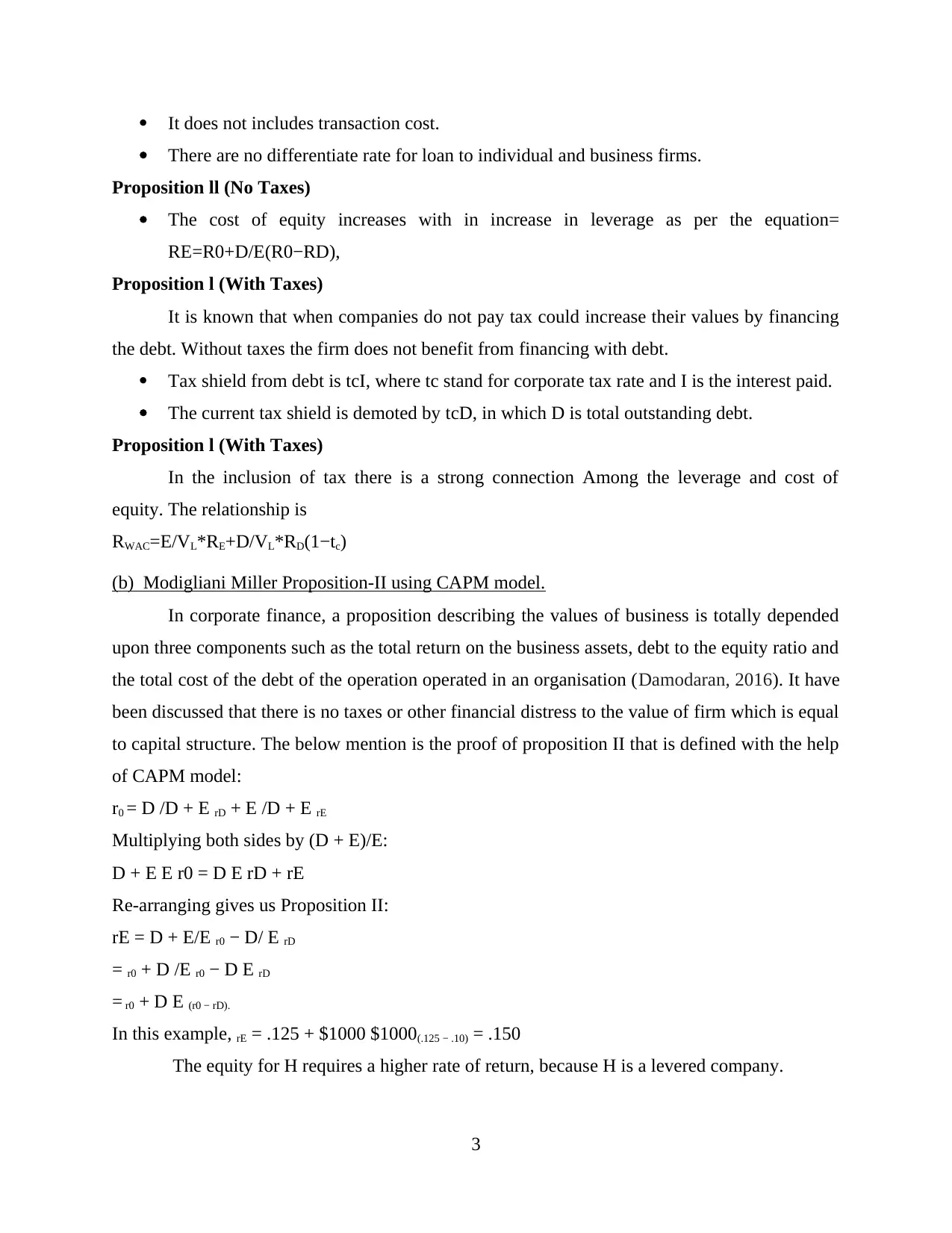
It does not includes transaction cost.
There are no differentiate rate for loan to individual and business firms.
Proposition ll (No Taxes)
The cost of equity increases with in increase in leverage as per the equation=
RE=R0+D/E(R0−RD),
Proposition l (With Taxes)
It is known that when companies do not pay tax could increase their values by financing
the debt. Without taxes the firm does not benefit from financing with debt.
Tax shield from debt is tcI, where tc stand for corporate tax rate and I is the interest paid.
The current tax shield is demoted by tcD, in which D is total outstanding debt.
Proposition l (With Taxes)
In the inclusion of tax there is a strong connection Among the leverage and cost of
equity. The relationship is
RWAC=E/VL*RE+D/VL*RD(1−tc)
(b) Modigliani Miller Proposition-II using CAPM model.
In corporate finance, a proposition describing the values of business is totally depended
upon three components such as the total return on the business assets, debt to the equity ratio and
the total cost of the debt of the operation operated in an organisation (Damodaran, 2016). It have
been discussed that there is no taxes or other financial distress to the value of firm which is equal
to capital structure. The below mention is the proof of proposition II that is defined with the help
of CAPM model:
r0 = D /D + E rD + E /D + E rE
Multiplying both sides by (D + E)/E:
D + E E r0 = D E rD + rE
Re-arranging gives us Proposition II:
rE = D + E/E r0 − D/ E rD
= r0 + D /E r0 − D E rD
= r0 + D E (r0 − rD).
In this example, rE = .125 + $1000 $1000(.125 − .10) = .150
The equity for H requires a higher rate of return, because H is a levered company.
3
There are no differentiate rate for loan to individual and business firms.
Proposition ll (No Taxes)
The cost of equity increases with in increase in leverage as per the equation=
RE=R0+D/E(R0−RD),
Proposition l (With Taxes)
It is known that when companies do not pay tax could increase their values by financing
the debt. Without taxes the firm does not benefit from financing with debt.
Tax shield from debt is tcI, where tc stand for corporate tax rate and I is the interest paid.
The current tax shield is demoted by tcD, in which D is total outstanding debt.
Proposition l (With Taxes)
In the inclusion of tax there is a strong connection Among the leverage and cost of
equity. The relationship is
RWAC=E/VL*RE+D/VL*RD(1−tc)
(b) Modigliani Miller Proposition-II using CAPM model.
In corporate finance, a proposition describing the values of business is totally depended
upon three components such as the total return on the business assets, debt to the equity ratio and
the total cost of the debt of the operation operated in an organisation (Damodaran, 2016). It have
been discussed that there is no taxes or other financial distress to the value of firm which is equal
to capital structure. The below mention is the proof of proposition II that is defined with the help
of CAPM model:
r0 = D /D + E rD + E /D + E rE
Multiplying both sides by (D + E)/E:
D + E E r0 = D E rD + rE
Re-arranging gives us Proposition II:
rE = D + E/E r0 − D/ E rD
= r0 + D /E r0 − D E rD
= r0 + D E (r0 − rD).
In this example, rE = .125 + $1000 $1000(.125 − .10) = .150
The equity for H requires a higher rate of return, because H is a levered company.
3
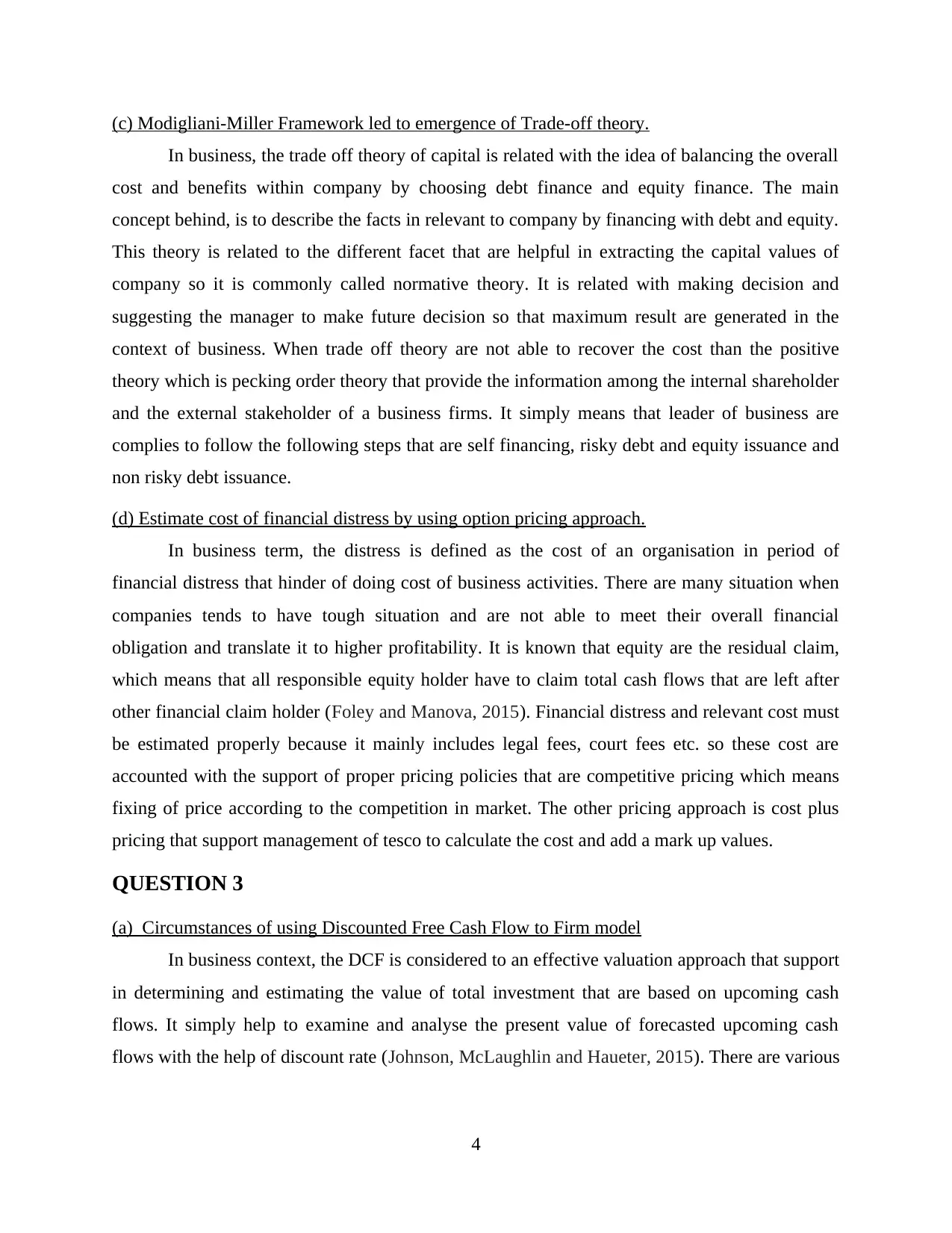
(c) Modigliani-Miller Framework led to emergence of Trade-off theory.
In business, the trade off theory of capital is related with the idea of balancing the overall
cost and benefits within company by choosing debt finance and equity finance. The main
concept behind, is to describe the facts in relevant to company by financing with debt and equity.
This theory is related to the different facet that are helpful in extracting the capital values of
company so it is commonly called normative theory. It is related with making decision and
suggesting the manager to make future decision so that maximum result are generated in the
context of business. When trade off theory are not able to recover the cost than the positive
theory which is pecking order theory that provide the information among the internal shareholder
and the external stakeholder of a business firms. It simply means that leader of business are
complies to follow the following steps that are self financing, risky debt and equity issuance and
non risky debt issuance.
(d) Estimate cost of financial distress by using option pricing approach.
In business term, the distress is defined as the cost of an organisation in period of
financial distress that hinder of doing cost of business activities. There are many situation when
companies tends to have tough situation and are not able to meet their overall financial
obligation and translate it to higher profitability. It is known that equity are the residual claim,
which means that all responsible equity holder have to claim total cash flows that are left after
other financial claim holder (Foley and Manova, 2015). Financial distress and relevant cost must
be estimated properly because it mainly includes legal fees, court fees etc. so these cost are
accounted with the support of proper pricing policies that are competitive pricing which means
fixing of price according to the competition in market. The other pricing approach is cost plus
pricing that support management of tesco to calculate the cost and add a mark up values.
QUESTION 3
(a) Circumstances of using Discounted Free Cash Flow to Firm model
In business context, the DCF is considered to an effective valuation approach that support
in determining and estimating the value of total investment that are based on upcoming cash
flows. It simply help to examine and analyse the present value of forecasted upcoming cash
flows with the help of discount rate (Johnson, McLaughlin and Haueter, 2015). There are various
4
In business, the trade off theory of capital is related with the idea of balancing the overall
cost and benefits within company by choosing debt finance and equity finance. The main
concept behind, is to describe the facts in relevant to company by financing with debt and equity.
This theory is related to the different facet that are helpful in extracting the capital values of
company so it is commonly called normative theory. It is related with making decision and
suggesting the manager to make future decision so that maximum result are generated in the
context of business. When trade off theory are not able to recover the cost than the positive
theory which is pecking order theory that provide the information among the internal shareholder
and the external stakeholder of a business firms. It simply means that leader of business are
complies to follow the following steps that are self financing, risky debt and equity issuance and
non risky debt issuance.
(d) Estimate cost of financial distress by using option pricing approach.
In business term, the distress is defined as the cost of an organisation in period of
financial distress that hinder of doing cost of business activities. There are many situation when
companies tends to have tough situation and are not able to meet their overall financial
obligation and translate it to higher profitability. It is known that equity are the residual claim,
which means that all responsible equity holder have to claim total cash flows that are left after
other financial claim holder (Foley and Manova, 2015). Financial distress and relevant cost must
be estimated properly because it mainly includes legal fees, court fees etc. so these cost are
accounted with the support of proper pricing policies that are competitive pricing which means
fixing of price according to the competition in market. The other pricing approach is cost plus
pricing that support management of tesco to calculate the cost and add a mark up values.
QUESTION 3
(a) Circumstances of using Discounted Free Cash Flow to Firm model
In business context, the DCF is considered to an effective valuation approach that support
in determining and estimating the value of total investment that are based on upcoming cash
flows. It simply help to examine and analyse the present value of forecasted upcoming cash
flows with the help of discount rate (Johnson, McLaughlin and Haueter, 2015). There are various
4
⊘ This is a preview!⊘
Do you want full access?
Subscribe today to unlock all pages.

Trusted by 1+ million students worldwide
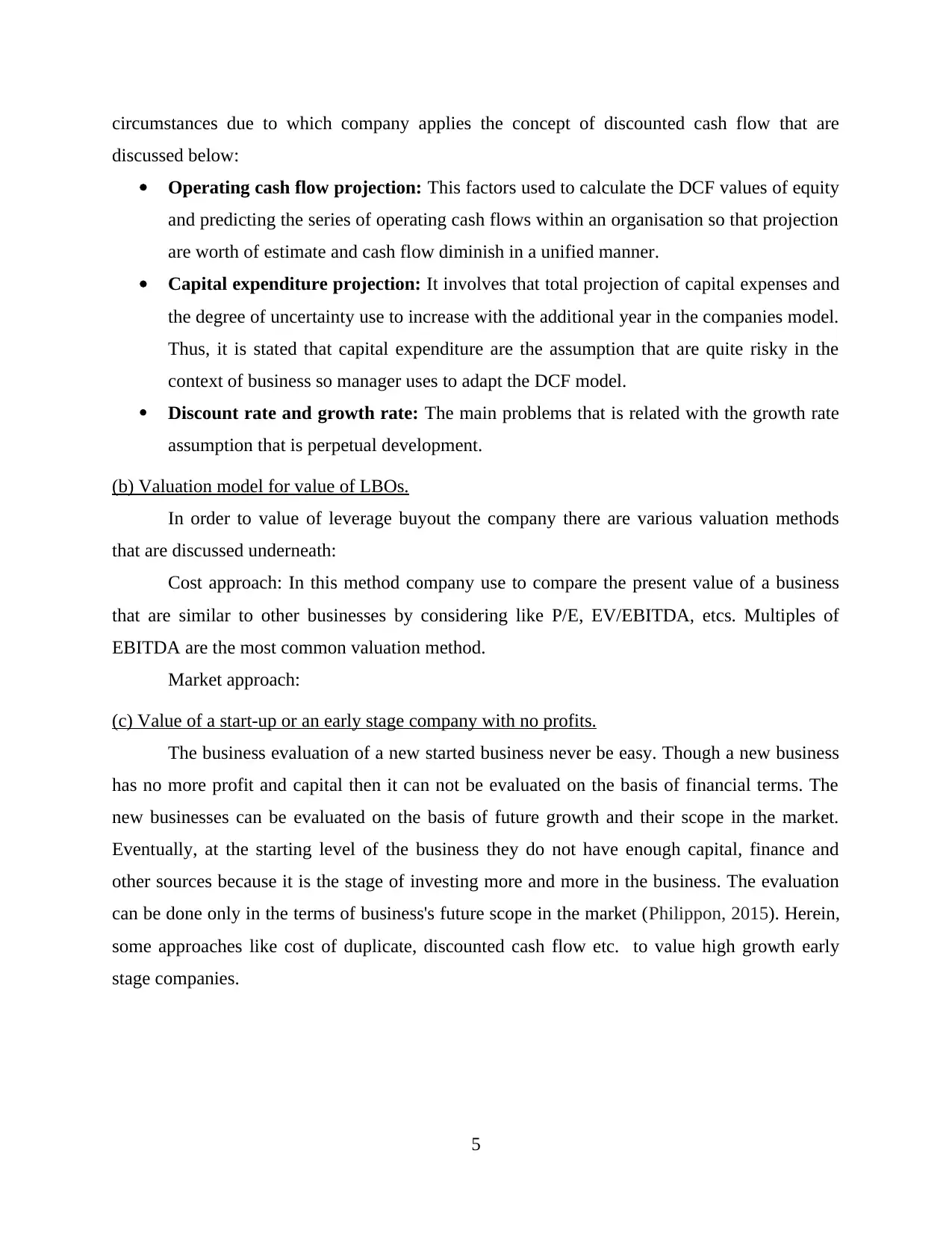
circumstances due to which company applies the concept of discounted cash flow that are
discussed below:
Operating cash flow projection: This factors used to calculate the DCF values of equity
and predicting the series of operating cash flows within an organisation so that projection
are worth of estimate and cash flow diminish in a unified manner.
Capital expenditure projection: It involves that total projection of capital expenses and
the degree of uncertainty use to increase with the additional year in the companies model.
Thus, it is stated that capital expenditure are the assumption that are quite risky in the
context of business so manager uses to adapt the DCF model.
Discount rate and growth rate: The main problems that is related with the growth rate
assumption that is perpetual development.
(b) Valuation model for value of LBOs.
In order to value of leverage buyout the company there are various valuation methods
that are discussed underneath:
Cost approach: In this method company use to compare the present value of a business
that are similar to other businesses by considering like P/E, EV/EBITDA, etcs. Multiples of
EBITDA are the most common valuation method.
Market approach:
(c) Value of a start-up or an early stage company with no profits.
The business evaluation of a new started business never be easy. Though a new business
has no more profit and capital then it can not be evaluated on the basis of financial terms. The
new businesses can be evaluated on the basis of future growth and their scope in the market.
Eventually, at the starting level of the business they do not have enough capital, finance and
other sources because it is the stage of investing more and more in the business. The evaluation
can be done only in the terms of business's future scope in the market (Philippon, 2015). Herein,
some approaches like cost of duplicate, discounted cash flow etc. to value high growth early
stage companies.
5
discussed below:
Operating cash flow projection: This factors used to calculate the DCF values of equity
and predicting the series of operating cash flows within an organisation so that projection
are worth of estimate and cash flow diminish in a unified manner.
Capital expenditure projection: It involves that total projection of capital expenses and
the degree of uncertainty use to increase with the additional year in the companies model.
Thus, it is stated that capital expenditure are the assumption that are quite risky in the
context of business so manager uses to adapt the DCF model.
Discount rate and growth rate: The main problems that is related with the growth rate
assumption that is perpetual development.
(b) Valuation model for value of LBOs.
In order to value of leverage buyout the company there are various valuation methods
that are discussed underneath:
Cost approach: In this method company use to compare the present value of a business
that are similar to other businesses by considering like P/E, EV/EBITDA, etcs. Multiples of
EBITDA are the most common valuation method.
Market approach:
(c) Value of a start-up or an early stage company with no profits.
The business evaluation of a new started business never be easy. Though a new business
has no more profit and capital then it can not be evaluated on the basis of financial terms. The
new businesses can be evaluated on the basis of future growth and their scope in the market.
Eventually, at the starting level of the business they do not have enough capital, finance and
other sources because it is the stage of investing more and more in the business. The evaluation
can be done only in the terms of business's future scope in the market (Philippon, 2015). Herein,
some approaches like cost of duplicate, discounted cash flow etc. to value high growth early
stage companies.
5
Paraphrase This Document
Need a fresh take? Get an instant paraphrase of this document with our AI Paraphraser

QUESTION 4
(a) Reasoning above use Put-Call parity.
Conceptualization is regarding the share debts holders and the equity shareholders. With
creating the changes with critical evaluation and control. As per put call parity, the shareholders
are entitled to get dividend and considerations in respect of their shareholding and the concept.
There is a concept of risk free rate and return on capital helps in determining the strategies and
plans for compensating the value of debentures and shareholders. The debts and changes are also
consider more stable and consecutive. The equity share owners and the shareholders mainly
impaired with their entity and ownership. For the critical evaluation it was evaluated with debts.
Value of equity with more call options. The value of equity call can be calculated by
implementing the Black-Scholes in which the options, the formula is defined as follows;
(b) Risky debt is interpreted as a long position
Debt equity finance is an option that helps to fulfil the finance requirement of business.
The use of calculation. To evaluate the theoretical value of debt holders it is evaluated by
considering the redemption duration after expiration.
6
(a) Reasoning above use Put-Call parity.
Conceptualization is regarding the share debts holders and the equity shareholders. With
creating the changes with critical evaluation and control. As per put call parity, the shareholders
are entitled to get dividend and considerations in respect of their shareholding and the concept.
There is a concept of risk free rate and return on capital helps in determining the strategies and
plans for compensating the value of debentures and shareholders. The debts and changes are also
consider more stable and consecutive. The equity share owners and the shareholders mainly
impaired with their entity and ownership. For the critical evaluation it was evaluated with debts.
Value of equity with more call options. The value of equity call can be calculated by
implementing the Black-Scholes in which the options, the formula is defined as follows;
(b) Risky debt is interpreted as a long position
Debt equity finance is an option that helps to fulfil the finance requirement of business.
The use of calculation. To evaluate the theoretical value of debt holders it is evaluated by
considering the redemption duration after expiration.
6
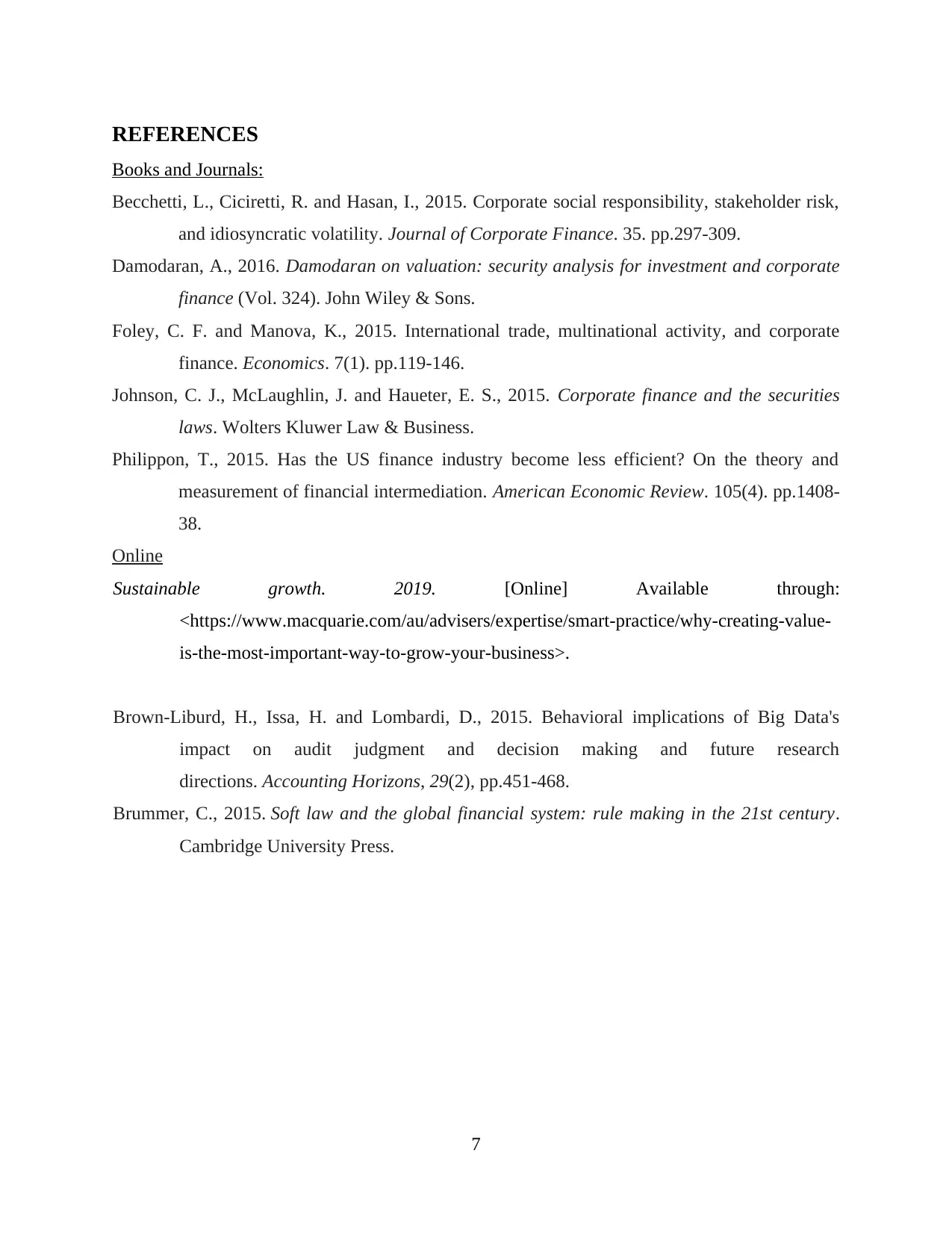
REFERENCES
Books and Journals:
Becchetti, L., Ciciretti, R. and Hasan, I., 2015. Corporate social responsibility, stakeholder risk,
and idiosyncratic volatility. Journal of Corporate Finance. 35. pp.297-309.
Damodaran, A., 2016. Damodaran on valuation: security analysis for investment and corporate
finance (Vol. 324). John Wiley & Sons.
Foley, C. F. and Manova, K., 2015. International trade, multinational activity, and corporate
finance. Economics. 7(1). pp.119-146.
Johnson, C. J., McLaughlin, J. and Haueter, E. S., 2015. Corporate finance and the securities
laws. Wolters Kluwer Law & Business.
Philippon, T., 2015. Has the US finance industry become less efficient? On the theory and
measurement of financial intermediation. American Economic Review. 105(4). pp.1408-
38.
Online
Sustainable growth. 2019. [Online] Available through:
<https://www.macquarie.com/au/advisers/expertise/smart-practice/why-creating-value-
is-the-most-important-way-to-grow-your-business>.
Brown-Liburd, H., Issa, H. and Lombardi, D., 2015. Behavioral implications of Big Data's
impact on audit judgment and decision making and future research
directions. Accounting Horizons, 29(2), pp.451-468.
Brummer, C., 2015. Soft law and the global financial system: rule making in the 21st century.
Cambridge University Press.
7
Books and Journals:
Becchetti, L., Ciciretti, R. and Hasan, I., 2015. Corporate social responsibility, stakeholder risk,
and idiosyncratic volatility. Journal of Corporate Finance. 35. pp.297-309.
Damodaran, A., 2016. Damodaran on valuation: security analysis for investment and corporate
finance (Vol. 324). John Wiley & Sons.
Foley, C. F. and Manova, K., 2015. International trade, multinational activity, and corporate
finance. Economics. 7(1). pp.119-146.
Johnson, C. J., McLaughlin, J. and Haueter, E. S., 2015. Corporate finance and the securities
laws. Wolters Kluwer Law & Business.
Philippon, T., 2015. Has the US finance industry become less efficient? On the theory and
measurement of financial intermediation. American Economic Review. 105(4). pp.1408-
38.
Online
Sustainable growth. 2019. [Online] Available through:
<https://www.macquarie.com/au/advisers/expertise/smart-practice/why-creating-value-
is-the-most-important-way-to-grow-your-business>.
Brown-Liburd, H., Issa, H. and Lombardi, D., 2015. Behavioral implications of Big Data's
impact on audit judgment and decision making and future research
directions. Accounting Horizons, 29(2), pp.451-468.
Brummer, C., 2015. Soft law and the global financial system: rule making in the 21st century.
Cambridge University Press.
7
⊘ This is a preview!⊘
Do you want full access?
Subscribe today to unlock all pages.

Trusted by 1+ million students worldwide

8
1 out of 10
Related Documents
Your All-in-One AI-Powered Toolkit for Academic Success.
+13062052269
info@desklib.com
Available 24*7 on WhatsApp / Email
![[object Object]](/_next/static/media/star-bottom.7253800d.svg)
Unlock your academic potential
Copyright © 2020–2025 A2Z Services. All Rights Reserved. Developed and managed by ZUCOL.





